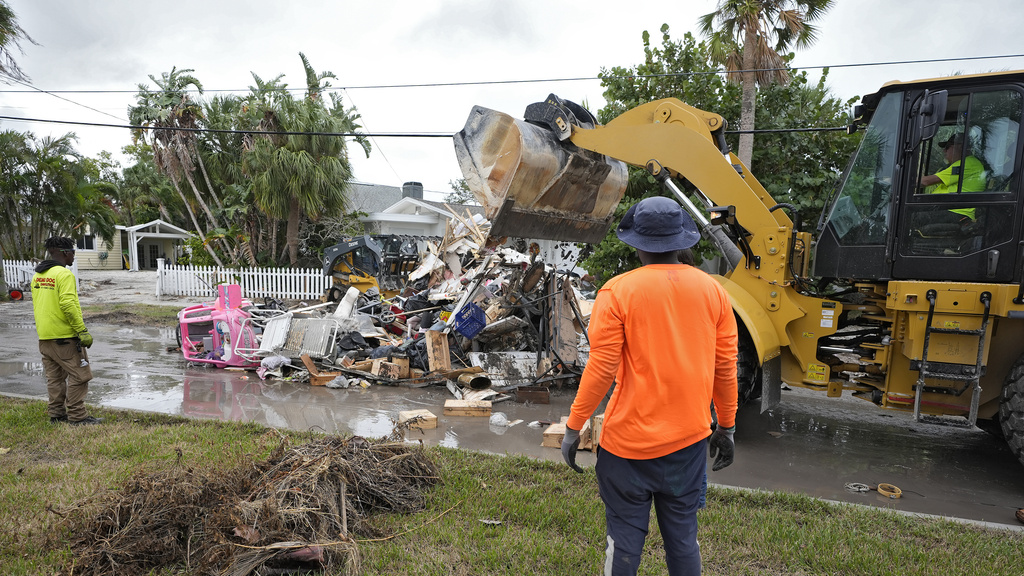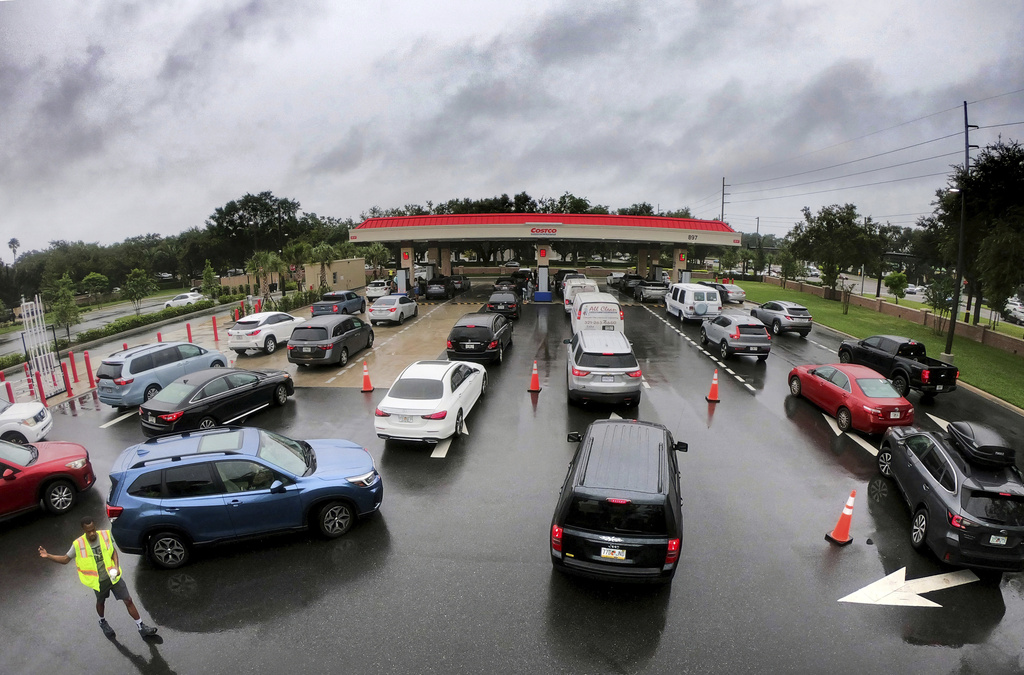Milton Targets Tampa Bay, Rapidly Strengthens to Category 5 \ Newslooks \ Washington DC \ Mary Sidiqi \ Evening Edition \ Hurricane Milton intensified into a Category 5 storm, heading directly toward the densely populated Tampa Bay region, threatening a potential direct hit on Wednesday. Officials issued evacuation orders and warned of significant storm surge and flooding, while Florida rushed to clear debris from Hurricane Helene, which struck less than two weeks ago. Milton’s rapid intensification and impending landfall raised concerns, prompting urgent preparations throughout the state.

Hurricane Milton Approaches Florida Quick Looks
- Hurricane Milton rapidly intensified to a Category 5, heading toward Tampa Bay.
- The storm is predicted to weaken slightly but could still hit as a Category 3 or higher.
- Milton threatens the same Florida coastline hit by Hurricane Helene just weeks ago.
- Tampa hasn’t experienced a direct hurricane hit in over a century.
- Evacuation orders are in effect for Tampa Bay and nearby areas as of Tuesday night.
- Forecasts predict 8-12 feet storm surges and up to 15 inches of rain in some areas.
- Tampa Mayor Jane Castor urged residents not to underestimate Milton.
- Governor DeSantis emphasized the urgency of clearing Helene’s debris to avoid projectiles.
- MIT professor Kerry Emanuel noted Tampa’s exposure and vulnerability.
- Milton’s rapid strengthening was due to a “pinhole eye” and unusually warm Gulf waters.
- Hillsborough County officials warned that remaining residents risk their lives and rescue teams.
- Tampa Bay Lightning’s NHL game and local airport operations were canceled due to the storm.
Deep Look
On Monday, Hurricane Milton quickly strengthened into a Category 5 storm, heading straight for Florida’s Gulf Coast and putting the densely populated Tampa Bay region at significant risk. With maximum sustained winds of 160 mph (257 kph), the powerful storm could make landfall in the Tampa Bay area on Wednesday, marking the first direct hurricane hit on the region in more than a century. As the state scrambles to prepare, there are growing concerns about the storm’s impact, particularly because this area was battered less than two weeks ago by Hurricane Helene.
Forecasters currently expect Hurricane Milton to weaken slightly before landfall, potentially dropping to a Category 3 storm or higher when it hits Florida’s western coast. The hurricane’s path is forecasted to cross central Florida, maintaining hurricane strength as it makes its way toward the Atlantic. Despite a predicted weakening, Milton’s arrival still poses a major threat to a state already grappling with the fallout from Hurricane Helene, which left at least 230 people dead across Florida and into the Appalachian Mountains.
Tampa Mayor Jane Castor issued a stark warning to residents, emphasizing the severity of the storm. “This is the real deal here with Milton,” she said at a news conference. “If you want to take on Mother Nature, she wins 100% of the time.” Her message was meant to underscore the need for people to heed evacuation orders and prepare adequately for the storm’s arrival. Florida Governor Ron DeSantis echoed this urgency, noting that debris from Hurricane Helene must be cleared to prevent it from becoming dangerous projectiles during Milton’s high winds. DeSantis emphasized, “We don’t have time for bureaucracy and red tape,” citing an incident where more than 300 vehicles loaded with debris from Helene were delayed due to a locked landfill gate, which state troopers had to forcibly open.
As of Monday, evacuation orders were already being put into effect across the region. Residents in areas adjacent to Tampa Bay, as well as those in mobile or manufactured homes, were urged to evacuate. Forecasts warned of an 8- to 12-foot storm surge in Tampa Bay and predicted between 5 and 15 inches of rain throughout mainland Florida and the Keys. The Tampa metropolitan area, which is home to more than 3.2 million people, faces an especially challenging scenario, as it has not experienced a direct hurricane hit in over a century. “It’s a huge population. It’s very exposed, very inexperienced, and that’s a losing proposition,” said MIT meteorology professor Kerry Emanuel.
Much of Florida’s west coast, including Lake Okeechobee—which is prone to flooding during intense storms—was under hurricane and storm surge watches. A hurricane warning was also issued for parts of Mexico’s Yucatan state, which was expected to feel some effects of the storm as it passed by. By midday Monday, Milton was approximately 720 miles southwest of Tampa, moving east-southeast at 9 mph. The storm had intensified quickly over the warm waters of the eastern Gulf of Mexico, benefiting from unusually high temperatures and a small, tightly packed “pinhole eye,” which meteorologists say can lead to rapid intensification.
In the Tampa Bay area, which is still recovering from Hurricane Helene, residents are racing against time to clear debris and prepare for another major storm. Twelve people died during Helene’s impact, and extensive damage was reported along a series of barrier islands stretching from St. Petersburg to Clearwater. In response to the impending arrival of Milton, Pinellas County lifeguards began removing beach chairs and other items that could potentially become dangerous projectiles. Throughout affected communities, debris such as stoves, furniture, and even refrigerators waited on sidewalks to be collected.
For residents like Sarah Steslicki of Belleair Beach, frustration has mounted over what they view as delays in debris removal following Helene. “They’ve screwed around and haven’t picked the debris up, and now they’re scrambling to get it picked up,” Steslicki said. “If this one does hit, it’s going to be flying missiles. Stuff’s going to be floating and flying in the air.” Steslicki’s concerns are shared by many who worry that any loose debris could turn deadly during a storm as powerful as Milton.
Hillsborough County, which includes Tampa, has ordered mandatory evacuations for areas near Tampa Bay as well as for all mobile and manufactured homes, with residents expected to comply by Tuesday night. Hillsborough County Sheriff Chad Chronister acknowledged the challenges of facing another hurricane so soon after Helene but stressed the importance of safety. “Yes, this stinks. We know that, and it comes on the heels of where a lot of us are still recovering from Hurricane Helene,” Chronister said. “But if you safeguard your families, you will be alive.”
Despite the urgency of evacuation orders, many residents remain reluctant to leave, recalling the chaos of previous storms like Hurricane Irma in 2017. During Irma, around 7 million people were urged to evacuate, resulting in massive traffic jams and fuel shortages that left many frustrated and vowing never to evacuate again. By Monday, some gas stations in the Tampa area had already run out of fuel, though Governor DeSantis reassured residents that more gas and diesel supplies were being delivered across the state.
As cars streamed northward on Interstate 75, Tanya Marunchak of Belleair Beach was conflicted about whether to evacuate. Her home had been flooded with over four feet of water during Helene, destroying all her furniture and vehicles. Despite this, Marunchak’s husband believed that their three-story house could withstand Milton. “We lost all our cars, all our furniture. The first floor was completely destroyed,” she said. “This is the oddest weather predicament that there has ever been.” Officials warned that those who choose to stay could be putting themselves and first responders at risk. “If you remain there, you could die, and my men and women could die trying to rescue you,” Hillsborough Fire Rescue Chief Jason Dougherty said.
Meteorologists have noted that Hurricane Milton’s rapid intensification was due in part to its compact “pinhole eye,” similar to those of Hurricanes Wilma in 2005 and Felix in 2007. Milton’s wind speeds increased by 92 mph within 24 hours—a rate surpassed only by Wilma and Felix. According to Colorado State University hurricane researcher Phil Klotzbach, Milton will likely undergo an eyewall replacement cycle, a natural process that replaces the storm’s small eye with a larger one, temporarily weakening wind speeds while expanding the storm’s overall size. The Gulf of Mexico’s warm waters provided ample “fuel” for this rapid strengthening, and an especially warm eddy likely played a role in pushing Milton to Category 5 status, said University of Albany hurricane scientist Kristen Corbosiero.
In preparation for Milton’s arrival, officials throughout Florida canceled school activities, opened shelters, and suspended road tolls in west-central parts of the state. Pinellas County, which includes St. Petersburg, converted schools into emergency shelters, while officials in Tampa made city parking garages available for residents wanting to safeguard their vehicles from potential flooding. The St. Pete-Clearwater International Airport announced it would close after the final flight on Tuesday, and Tampa International Airport planned to suspend operations starting Tuesday as well. Orlando International Airport—the nation’s seventh busiest—will also stop operations starting Wednesday morning.
The Tampa Bay Buccaneers made arrangements to relocate their operations to the New Orleans area ahead of Sunday’s NFL game against the Saints. Additionally, the Tampa Bay Lightning canceled their NHL game against the Nashville Predators that was scheduled for Monday.
Florida’s Gulf Coast has experienced an unusual concentration of storms in recent years. In just 13 months, three hurricanes—including Helene—have battered Florida’s Big Bend region. Southwest Florida, including Fort Myers, is still rebuilding after Hurricane Ian caused $112 billion in damages in 2022. Comparisons have also been made to 2004, when five major storms struck Florida in just six weeks, highlighting the increasingly challenging storm seasons that have affected the state.
As Milton approaches, officials hope that ongoing preparation efforts will help mitigate the damage and save lives. However, given the storm’s strength and the vulnerable state of many affected areas still recovering from Helene, there is a sense of urgency and anxiety throughout the region. With the lessons from previous storms fresh in their minds, residents and officials alike are doing everything possible to brace for yet another dangerous encounter with Mother Nature.
Milton Targets Milton Targets Milton Targets Milton Targets Milton Targets Milton Targets







